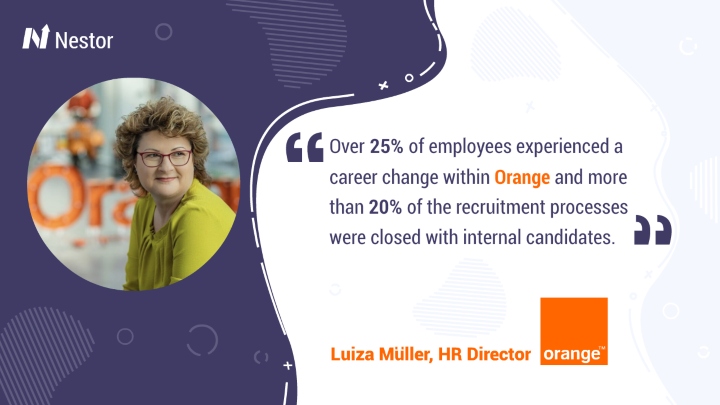
The COVID-19 pandemic continues to reshape our priorities, ways of working, living, thinking, collaborating etc. We are learning new ways of doing things, communicating and connecting. In other words, everything is changing. And change is the only constant.
So how can you, as an HR professional, help and support employees to embrace the change, understand their needs and act proactively to a better employee life cycle? As a knowledgeable HR professional, you have lots of tools, practices and experience to be successful in this journey.
Undoubtedly, the biggest impact you might have is by connecting with your employees, understanding their pains, needs, what drains their energy, what motivates them, what are their learning appetite and needs, and provide them the necessary tools to partner with you and co-create a meaningful and mission-driven career and employment experience.
Employee surveys: be an early adopter of data
Regardless of the size of the company, the sooner you introduce data analytics as part of the foundation of your decision making process, the higher and more meaningful your employee engagement will be. You either go with qualitative (1:1 interviews, group discussions, focus groups etc) or quantitative research. And here’s where surveys are of great help. Especially with larger teams.
The most commonly used (maybe even misused) employee survey is the employee engagement survey. These kinds of surveys measure your employees’ work involvement, willingness and reasons to stay, motivation, inter- and intra-department relationships management. In other words, the purpose of the employee engagement survey is to identify, measure and act upon the factors that help your employees to perform.
As follows, we’ll dive into the power of surveys by proposing several ideas of what you can measure in the upcoming year. So, use these last days of December to plan and create a people strategy that will really make sense to your employees and your company. Remember, what works for somebody might not work for you, and vice versa.
Surveys to assess employees experience and wellness
Mood or pulse surveys
Mood surveys help you take the pulse on how employees are feeling right now. What are they struggling with? Measuring employees’ mood might be helpful in spotting on time depression or burnout. Being mindful about these situations, preparing and guiding managers to be able to support their colleagues might be a game changer. Especially in such times as we live now with the Covid-19 pandemic.
Usually pulse surveys are 1-3 questions, asking respondents things like:
- How are you feeling today? (to make it playful, you might use an emoji scale)
- What is your number one challenge right now?
- What would you like to share with us (the HR team)?
Repeat this kind of mood survey to identify patterns and possible risks of depression, anxiety and burnout.
Employee surveys: wellness assessment
There are 8 dimensions of wellness: physical, intellectual, emotional, social, spiritual, vocational (occupational), financial and environmental. For a healthy state of mind and body, it is beneficial to look holistically at them and build habits to sustain each of these dimensions.
Employees want to feel cared for by their employer. So embrace this chance to actually have an impact and improve their lives. When designing the wellness assessment questionnaire and before formulating your questions, think of:
- How are your employees taking care of their bodies? Hint: maybe workshops on nutrition will help your employees understand and learn how to nurture their body correctly and stay more focused.
- Are they intellectually challenged? Do you offer support and encouragement to constantly learn and grow?
- Do they feel appreciated? Are they able to self-regulate their emotions? How can you assess that?
- Is finding and working with purpose something important to them?
- Do they have or need training on making informed financial decisions?
You can also start with one dimension at a time and assess employees wellness through pulse surveys. For example, you might ask the following questions:
- How satisfied are you with your financial decisions? or, How satisfied are you with your ability to understand and cope with your emotions? and,
- What is your challenge in relation to your financial decisions? What are you struggling with right now?
Employee surveys: onboarding assessment
Onboarding is a critical stage of your employee lifecycle as it lays the groundwork for the company culture, setting your new hires to be successful (or not) within the organisation. Assessing and constantly improving your onboarding process might increase the chances the new hires will adapt to the culture, new role, new team.
The onboarding’s purpose is to help your new hires to be productive. So knowing what are the strengths and the weaknesses of your onboarding process will help you improve it and set your new hires to success.
Start by identifying your target. For example, who joined the company in the last 3-6 months? Subsequently, you might ask questions or statements like:
- How would you rate your job responsibilities comparing with the expectations set during the hiring process?
- I am happy with the decision I’ve made to join the company.
- I have all the resources and tools I need to be productive in my new role.
- My team didn’t provide the information and access I need to be successful in my new role.
- I know where to look for the information I need to do my job.
- Training received during the induction period covered my needs and prepared me to be successful in my new role.
- I feel accepted by my team.
- I feel appreciated by all of my colleagues.
- What is the biggest challenge you are facing since you’ve joined the company?
Candidate feedback
Create connections with the candidates that apply and enter the recruitment process with your company. Your candidates are a great pipeline from whom you can receive valuable feedback that might enrich your further recruitment process. Additionally to that, candidates who feel their opinion matters might become your future ambassadors, even if they were rejected for a specific role.
Are you wondering why you can’t find proper candidates? Or why is your offer acceptance rate low? How can you improve your recruitment process and candidates’ journey? Go directly to the source and find out from them – your candidates. Here are some suggestions you might include:
- Based on your experience with us, on a scale from 0 to 10, how likely are you to recommend [your company’s name] to your family and friends?
- Please provide details on the rating above.
- The recruiter provided all the information I needed about the company and the role.
- The recruiter inspired and motivated me to go further in the recruitment process with the company.
- How would you rate the length of our recruitment process you’ve been involved in?
- I received appropriate answers to all my questions.
- The interviewers were well informed and prepared.
- The instructions from the assignment were clearly explained.
- The assignment had unrealistic deadlines.
- The assignment had unrealistically difficult tasks.
eNPS
Employee net promoter score (eNPS) is a metric that measures your employees’ likelihood to recommend your company as a good place to work. Avoid overdoing it and keep it simple. You’d be surprised by the input you might receive. For a successful eNPS, here’s what you can ask:
- On a scale from 0 to 10, how likely are you to recommend [your company’s name] as a good place to work to your friends and family?
- Please share your thoughts on the rating above.
- How can we improve?
Key aspects and best practices
When planing successful employee surveys that truthfully show the reality within your company, make sure you are creating a careful and informed design. For example, try to design 1/3 of the questionnaire the answer to which should be negative. People have a bias to agree with a statement, especially when it comes in the workplace context.
Set clear objectives before designing and formulating your questions. What works for a company, might not be relevant for your company. In this article, we covered some of the key aspects to consider when formulating questions. Remember, poorly written questions will return bad data. So ask yourself:
- What’s the real challenge your company and employees are facing now?
- Why are you doing this?
- What are you planning to do with the results?
- How will you measure (1) that the survey campaign was successful and (2) what metrics and scales will better suit the purpose of the survey?
- What tools do you have access to? Google forms, SurveyMonkey, Typeform or maybe an integrated, specialised tool, such as Nestor?
Share the survey results with your colleagues and communicate how you will take this information and turn it into actionable next steps and initiatives to improve their journey. And keep your promise. Otherwise your employees might lose the motivation to participate in further surveys.
Final thoughts
Use employee surveys to gather and crunch data. However, do not stop here, go further and connect the dots. Critically think about the data you’ve collected, share results with your employees (be aware of the confidentiality, however) and think of ways to integrate their feedback into your future initiatives.
In part two we’ll cover surveys to assess employee development, effectiveness and organisational culture. Stay tuned!








